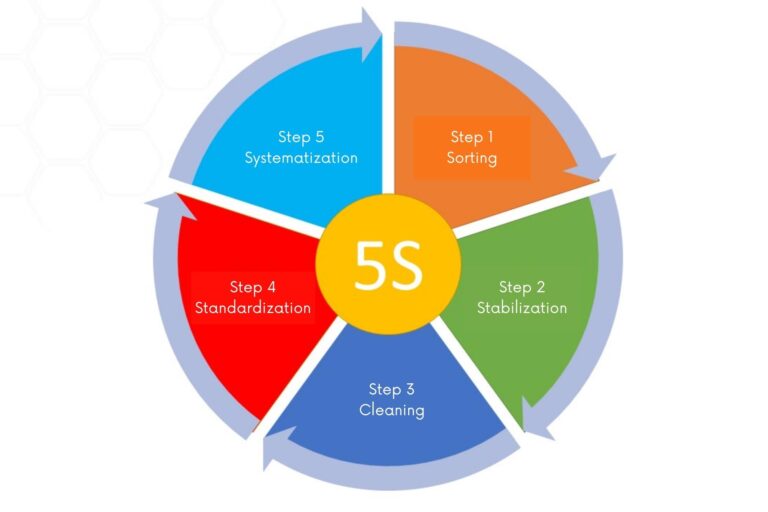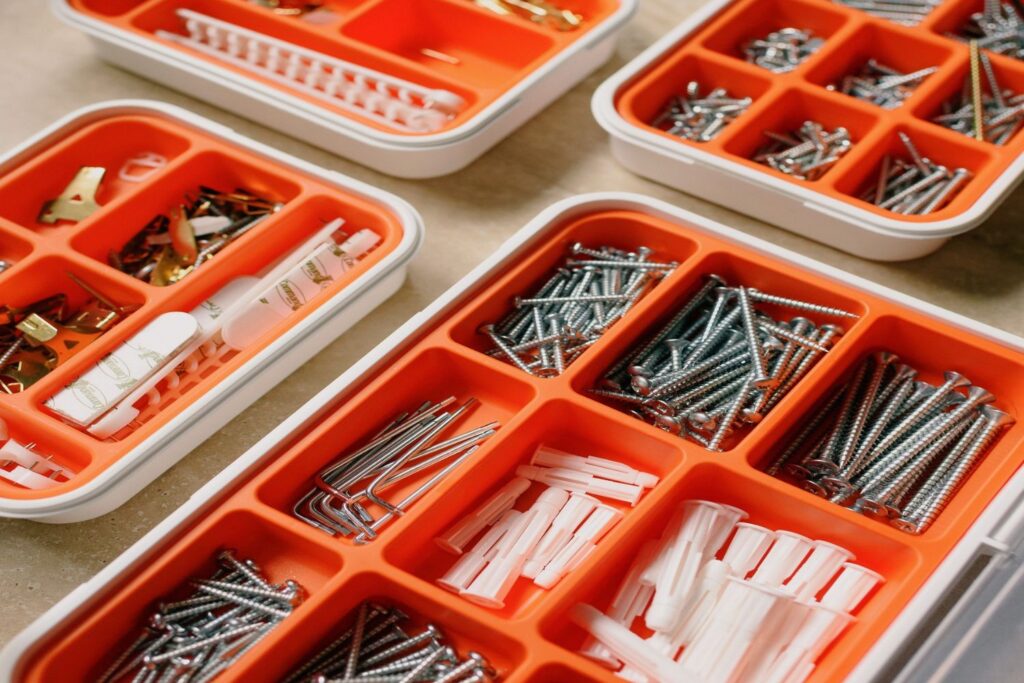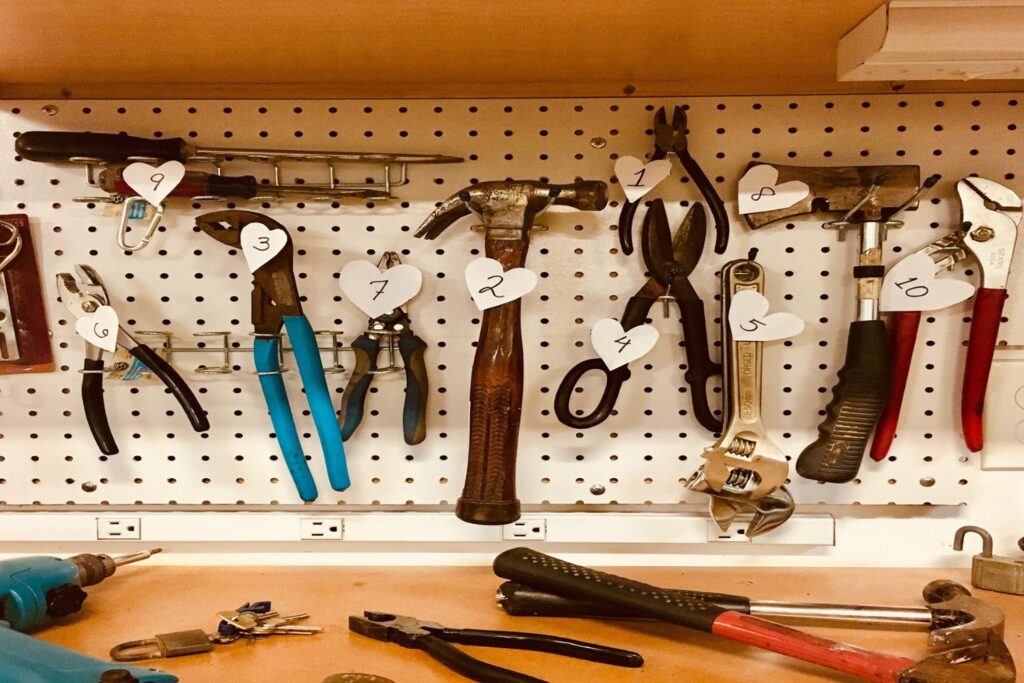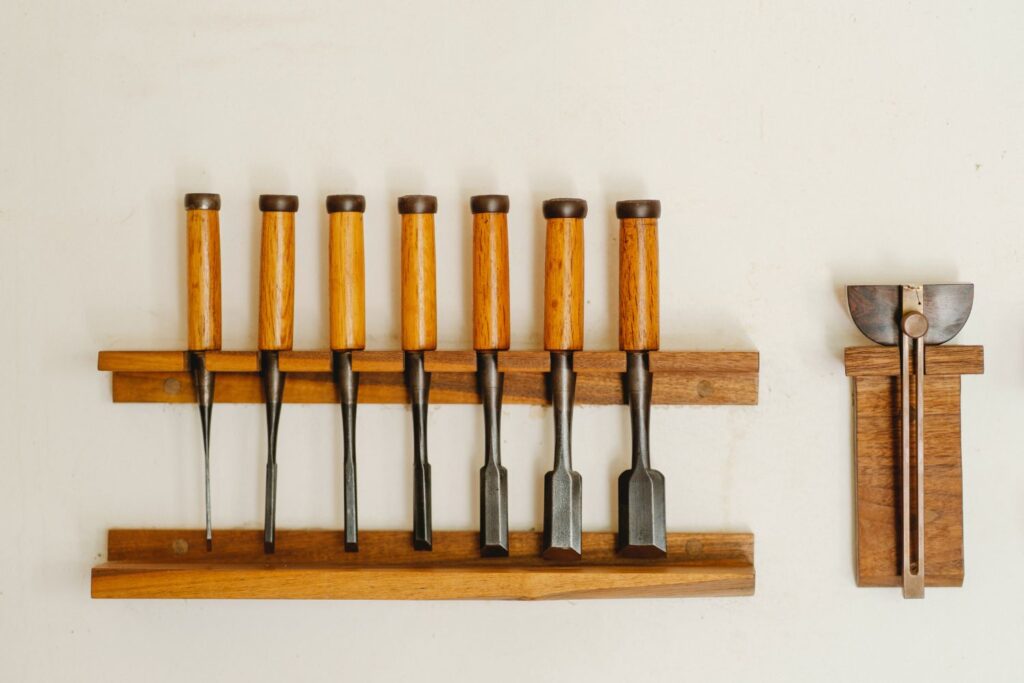Narzędzia
- 5S
Workplace organization - KANBAN
Material management - LEAN OFFICE
Optimization in the office - DESIGN THINKING
A way of thinking - LAYOUT
Internal logistics - SMED
Rapid changeover - SOP
Standardization of work - TPM
Total Productive Maintenance - TWI
Training Within Industry - KPI
Visual Management - VSM
Value Stream Mapping
Find out more from the experts
Talk to Lean Idea
+48 607 86 49 85
5S
Company structuring system
A Japanese project for the internal organisation of a company. It is based on cyclical action according to always the same pattern.
Identification of the necessary tools, instruments, components at work
Identification of a specific location for each work tool
Maintaining an orderly and clean workplace
Definition of standards for implementation and adherence to the above steps
Translate previously implemented actions into habits

Step 1: Seiri, or sorting
Look around your workplace. Review the tools. Are there any tools that you have not used in the last year? Do you know the purpose of each of them? Are the semi-finished products/components needed for your work always easily accessible? If not, how long do you have to search for them? Are there any “just-in-case” items (i.e., “I might need it someday, so I’ll keep it”) among the elements of your work area?
Conduct a selection. You can ask other team members for help. Participants are equipped with, for example, red cards. They attach them to any item that they believe should not be in that work area. You can explain how and how often you use a particular tool or component.
Remove the labeled items. Some of them may be temporarily moved to the so-called red area. They can be taken back if a thorough analysis shows their usefulness for work.
Step 2: Seiton or stabilization
Arrange the selected things well. Essential items in the workplace should be arranged in a place easily accessible to everyone. The goal of this activity is to create a situation in which finding and putting away these elements will be easy and intuitive. This will allow you to eliminate unnecessary movement when looking for and transferring materials, improve the quality of working conditions, make it easier to detect discrepancies, and have better control over the process.
How to do it?
- Designate an appropriate place for each item.
- Make sure it is easily accessible to everyone who uses this workstation.
- Describe each item and mark its storage location.
Visual management is helpful in implementing systematics in the workplace. These are all solutions that can be applied to quickly and clearly present the way of work, the status of tasks being performed, and also to control the condition and location of workstation equipment without the need to ask questions.
Visual management techniques:
- clearly defined storage areas (lines, signs, labels, storage areas)
- color coding and arrows
- marking maximum and minimum levels
- shadow boards
Each tool is placed in a designated place, allowing for instant identification of any missing items and determining the routine for picking up and putting away each of the tools. Employees can find and identify work tools.
It is worth noting that the main final effect of the second stage of the 5S method is to obtain transparency and full visibility of the workplace so that EVERYONE can use it in the expected way.
Step 3: Seiso or cleaning
The most important goal of this step is to make employees understand that keeping tools, equipment, and the workplace clean is a systematic and repeatable activity. It cannot only be done in anticipation of a visit or inspection.
What does it involve?
Cleaning as part of 5S involves:
- establishing what, who, how, and how often tools/equipment/workstations will be reviewed and kept clean
- performing cleaning, maintenance, and repairs of tools/equipment
- taking care of the workplace environment (table, desk, floor, storage area, etc.)
- preparing a cyclical schedule for maintaining the cleanliness of the workstation
Benefits:
- keeping equipment ready for use
- detecting damage to equipment, tools, and machines before use
- preventing breakdowns and downtime
- establishing the best standard for a given workstation
- improving process and product quality, reducing downtime
- reducing quality costs
The first cleaning as part of the 5S process takes the longest, after which it is just a matter of maintaining cleanliness. It is optimal to implement a permanent rule in the company that the last 5-10 minutes of work (every day, at each workstation) is devoted to tidying up the workstation (also on production lines).
Step 4: Seiketsu or standardization
Constant habits
The aim of this stage is to establish standards for implementing and adhering to the first three steps of the 5S method. Standardization enables the achievement of repeatability of implemented changes, improvement of the work station and development of good habits.
Visual management
During standardization, detailed instructions for performing all tasks within the first three steps of 5S are created, and the scope of tasks and responsibilities of employees for 5S actions is defined. Visual information about work processes, layout of semi-finished products, and tools should appear at workstations. These are easy-to-understand and controllable instructions in the form of pictures.
Everyone participates in standardization
Standards for the placement and labeling of tools, work items, materials, and equipment at workstations should be known and common throughout the organization. Standards and procedures must be clear and easy to understand, so the widest possible range of employees in a given area should be involved in their development.
Benefits for employees
- changing the scope of duties for employees involves only a short training period, thanks to existing standards
- each employee is aware of their 5S responsibilities
- employees do not repeat undesirable actions and prevent a return to previous incorrect habits
Step 5: Shitsuke or systematization
The role of management is to ensure that the actions implemented in the previous steps are transformed into habits. Developing habits is a long-term and demanding process that requires commitment. Step 5 involves changing thinking patterns and habits. Changes in organizational culture require active participation of management to make the implementation of the 5S method effective.
Workplace audits are the best tool for controlling and maintaining the system. It is necessary to check whether employees comply with the standards developed in the previous step. Consistency and adherence to the audit schedule and checklist allow for immediate identification of errors and identification of necessary tasks for their elimination.
Benefits of implementing 5S.
Proper implementation of the final “S” affects the effectiveness of all stages, allowing to achieve:
- high work efficiency
- better product quality
- workplace safety
- comfort and ergonomics
- employee satisfaction and engagement.
Get in touch and we will advise you!





